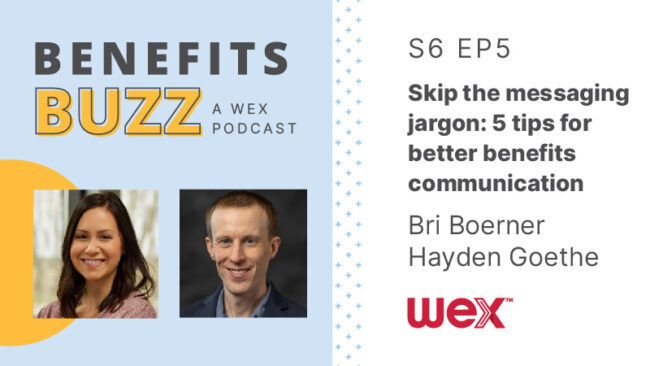Stay connected
Subscribe to our Inside WEX blog and follow us on social media for the insider view on everything WEX, from payments innovation to what it means to be a WEXer.

Did you know that, when employees were asked on a scale of 1 to 10 how confident they are in their understanding of their benefits, 34% chose a number of 7 or less. Only 25% responded with a 10. That was just one of the findings from a survey of benefits participants we launched in May 2023.
Often, employees feel confused about their benefits plans options, especially if their employer is using “complicated HR jargon” in their benefits messaging. How can your benefits messaging cater to your employees through benefits education? Let’s explore tips on how employers can effectively communicate benefits messaging to employees in a way that’s relatable and easy to understand.
Trying to understand benefit plans and the accompanying “HR jargon” can be complicated and a source of frustration for employees. As Bri Boerner, senior operational writer, global talent development at WEX explained in the latest Benefits podcast episode, “It may seem like a barrier if they just see a term they don’t understand. They don’t have background on it and then it’s scary and daunting.”
Employers should make a concerted effort to simplify the language used in communications to ensure employees can easily understand their options and make informed decisions. Rather than using acronyms and technical terms, employers could use simple language and meaningful stories to help employees visualize and understand their benefits. “I think it’s really important to tie it back to things that are meaningful to [employees]….their finances, their well-being, their family’s well-being,” said Hayden Goethe, senior content marketing strategist at WEX on our podcast episode. “It’s about what a health savings account or a flexible spending account can do for them.”
One main reason why employees don’t understand their benefits is a lack of communication from their employers. If benefits information is only provided during open enrollment, employees may forget about their benefits package or not fully understand their options. Employers should consider year-round benefits communication to ensure that employees are up-to-date and informed about their benefits.
When asked in our survey how often they would like to receive tips/resources about their benefits, the most popular answer was monthly (44% of respondents). However, you could create opt-in opportunities for more frequent communications for employees who are interested in that. Employees also told us their preferred methods to receive benefits education are:
To effectively communicate, it’s vital to get on your audience’s level and use language that they understand. Unfortunately, a lot of the terms used in the employee benefits space are not commonly used in everyday conversation.
When we surveyed our benefits participants, another question we asked was about their comprehension level for some of our terms. Based on their responses, a few of the most misunderstood terms are:
When using these terms, you may want to explain what they mean upfront or link to a resource that provides additional explanation for those who need it.
There are a variety of strategies employers and HR leaders can use to make the benefits enrollment process more enticing for employees, including:
“At WEX, we have a virtual open enrollment or multiple fairs depending on the plan,” said Boerner. “Employees can visit when it’s most convenient for them.”
Increased convenience to benefits education can have a significant impact on an employee’s ability to understand their benefits. Provide easily accessible resources like online portals, mobile apps, and digital tools to help employees access information about their benefits at any time and in any location.
These resources can help eliminate barriers that may prevent employees from engaging with their benefits, such as time constraints or difficulty navigating complex benefits information. Overall, increased convenience in benefits education leads to better-informed and satisfied employees, which often translates to improved productivity, employee retention, and overall company success.
Employee communication was just one of the topics we focused on with our 2023 benefits participant survey. Would you like to learn more about the survey results? Check out our infographic below.

The information in this blog post is for educational purposes only. It is not legal or tax advice. For legal or tax advice, you should consult your own legal counsel, tax and investment advisers.
WEX receives compensation from some of the merchants identified in its blog posts. By linking to these products, WEX is not endorsing these products.
Subscribe to our Inside WEX blog and follow us on social media for the insider view on everything WEX, from payments innovation to what it means to be a WEXer.